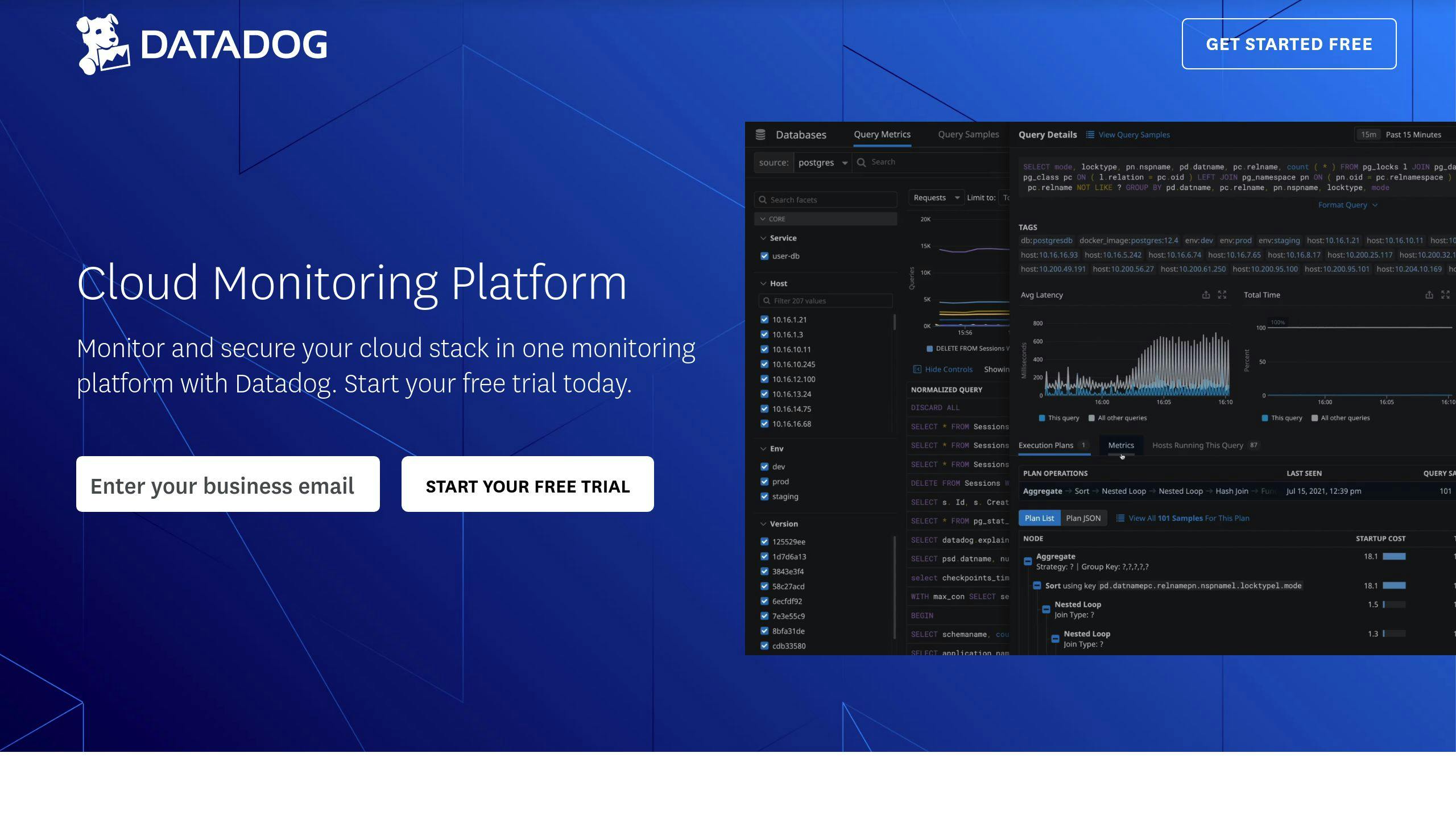Anomaly correlation helps IT teams quickly pinpoint the root causes of system issues. Here's how eyer.ai and Datadog stack up:
eyer.ai:
- AI-powered platform that adapts to your specific setup
- Connects metrics across systems to identify problems
- Works with open-source tools like Telegraf and Prometheus
- More affordable than some competitors
Datadog:
- Uses Watchdog AI to detect issues across infrastructure
- Integrates with 775+ tools and services
- Tightly links logs and metrics for faster troubleshooting
- Can be expensive for large-scale use
Quick Comparison:
| Feature | eyer.ai | Datadog |
|---|---|---|
| Anomaly Detection | Learns from your data | Uses Watchdog AI |
| Integrations | Open-source focused | 775+ options |
| Pricing | Lower cost | Higher cost |
| Maturity | Newer platform | Established player |
Both tools aim to speed up root cause analysis, but eyer.ai offers a more flexible, cost-effective solution while Datadog provides a comprehensive, battle-tested platform.
Related video from YouTube
1. eyer.ai

eyer.ai is shaking up the AIOps world with its AI-powered observability platform. Let's look at what makes it stand out.
Anomaly Detection
eyer.ai's core strength? Its smart anomaly detection system. It uses machine learning to spot weird patterns in performance data. This helps businesses catch problems early.
What's cool is how it adapts to each customer's setup. This means it's better at finding real issues and not crying wolf.
Metrics Correlation
Here's where eyer.ai really shines. It doesn't just find anomalies - it connects the dots between different metrics across your systems. This gives you a clearer picture of what's causing problems.
Think of it like this: If your CPU usage spikes, your database slows down, and your app starts lagging, eyer.ai can quickly point to the likely culprit. It's like having a super-smart IT detective on your team.
Integration Options
eyer.ai is built to play nice with others. It's headless and API-based, which means it's super flexible. It works with popular open-source agents like:
- Telegraf
- Prometheus
- StatsD
- Open Telemetry
Got a favorite monitoring tool? Chances are, eyer.ai can work with it. Plus, it's starting to support Boomi and Microsoft Azure, which is great news if you're using those platforms.
Price Analysis
eyer.ai doesn't shout its prices from the rooftops, but they position themselves as a cheaper option compared to big names like Datadog. They offer free trials and money-back guarantees, so you can test the waters without diving in headfirst.
They even have free plans for developers. So if you're a small team or flying solo, you can give it a spin without breaking the bank.
In the crowded AIOps market, eyer.ai is trying to be the smart choice - cheaper, faster, and more effective at monitoring time series data. With its mix of smart anomaly detection, clever metrics correlation, and flexible integration, it's making a strong case for businesses looking to up their IT game.
2. Datadog

Datadog is a big player in cloud monitoring. They offer tools for spotting issues and finding their root causes. Let's see how Datadog compares to eyer.ai in key areas.
Anomaly Detection
Datadog uses Watchdog, an AI system, to find performance problems across your entire setup. It's smart - it can group related issues without you having to set it up manually.
Picture this: Your online store's sales suddenly drop. Watchdog might flag unusual patterns in your payment system, database queries, and user logins all at once. This big-picture view helps you connect the dots faster.
Metrics Correlation
Datadog is great at linking metrics across your system. They offer a few ways to connect logs with metrics:
- Click on any log in the Log Explorer to see related metrics.
- In Dashboards, click on data points to view connected logs and metrics.
- In the Metrics Explorer, pick a metric to graph and easily find related logs.
This tight connection between logs and metrics helps you find the root cause of problems quickly.
Integration Options
Datadog works with over 775 different tools and services. They have three main types of integrations:
1. Agent-based
These use Python to define what metrics to collect. You install them with the Datadog Agent.
2. Authentication-based
These need API credentials. They cover popular services like Slack, AWS, and Azure.
3. Library
These use Datadog's API to keep an eye on apps in specific programming languages.
This flexibility means Datadog can fit into almost any tech setup, making it a good choice for all kinds of businesses.
Price Analysis
Datadog's pricing is based on how much data you use. They charge the same price per GB no matter how much you use. But it can get a bit complicated:
- You pay an extra $2.50 per million log events each month.
- If you go over your monthly log limit, you'll pay 50% more.
- They use "highwater mark" billing for watching apps and infrastructure.
Datadog offers a 14-day free trial. But it's worth noting that some competitors, like New Relic, give you 100 GB of free data every month for all types of data.
Datadog can be pricey - the average contract is $386,702. But there's room to negotiate. One user said:
"We have a $1M+ contract with Datadog. They offered 4% for a 2 year and 7% for a 3 year in the form of a one-time promotional discount."
This shows that if you're using Datadog on a large scale, you might be able to save a lot by committing to a longer contract.
sbb-itb-9890dba
Strengths and Limitations
Let's dive into how eyer.ai and Datadog stack up in anomaly correlation for root cause analysis:
eyer.ai
eyer.ai brings some cool stuff to the table:
- It learns from YOUR setup. No one-size-fits-all here.
- It's great at connecting the dots between different metrics.
- Works with popular open-source tools you might already use.
- Won't break the bank like some of the big players.
But it's not all sunshine and rainbows:
- It's the new kid on the block. Might not have ALL the bells and whistles yet.
- Right now, it's mostly playing nice with Boomi and Microsoft Azure.
Datadog
Datadog's been around the block:
- Their Watchdog AI is like a bloodhound for performance issues.
- It plays well with others - over 775 tools and services!
- It's a pro at connecting logs and metrics.
But watch out for:
- Their pricing? It's like solving a Rubik's cube.
- It can get pricey, especially if you're running a big operation.
Let's break it down side-by-side:
| Feature | eyer.ai | Datadog |
|---|---|---|
| Anomaly Detection | Learns your quirks | Watchdog sniffs out issues |
| Metrics Correlation | Connects the dots | Logs and metrics, BFFs |
| Integration Options | Plays with open-source | 775+ friends to choose from |
| Pricing | Easier on the wallet | Might need a bigger piggy bank |
| Market Position | Fresh face, moving fast | Old hand, lots of fans |
So, what's the deal? eyer.ai might be your jam if you want something that adapts to you and won't cost an arm and a leg. Datadog? It's got ALL the tools, but you might need a bigger budget.
As Rohit from Zluri's Community and Marketing Team puts it:
"AIOps platforms emerge as indispensable tools for IT managers aiming to navigate the complexities of modern IT operations."
Translation? These tools aren't just nice to have - they're becoming must-haves for IT folks trying to keep their heads above water in today's tech world.
Summary
Anomaly correlation is shaking things up in root cause analysis. Let's see how eyer.ai and Datadog are tackling this:
eyer.ai: The New Contender
eyer.ai is making noise with its AI approach:
- It learns and adapts to your setup, cutting down false alarms
- It's good at connecting different metrics across your system
- It's cheaper than the big players
But it's new, so it's still building out features and integrations.
Datadog: The Veteran
Datadog brings experience:
- Watchdog AI spots issues across your infrastructure without manual setup
- It works with over 775 tools and services
- It tightly integrates logs and metrics to find problems fast
The downside? It can be tricky to set up and it's not cheap.
Performance Face-Off
Let's look at some numbers:
| Model | Overall Mean Average Precision (MAP) | Improvement over Baseline |
|---|---|---|
| trACE | 0.98 | Up to 34% |
| Datadog's Watchdog | Not specified | Significant, but exact figures unavailable |
| eyer.ai | Not specified | Claims to be "faster and better" than Datadog |
trACE hit 98% MAP, beating other methods by 1% to 34%. That's the bar to beat.
Datadog and eyer.ai don't share exact figures, but both say they're much better at root cause analysis.
Real-World Example
Here's a real case:
In February 2023, a big e-commerce site had issues for 6 hours. Datadog's Watchdog RCA found that a bad 'address-service' deployment was causing errors and slowdowns. The team quickly rolled back the deployment, saving time and money.
This shows how good anomaly correlation can cut down problem-solving time.
What's Next?
As IT gets more complex, good anomaly correlation is a must-have. With IT outages expected to cost 60% more per hour by 2024, tools like eyer.ai and Datadog are crucial.
The bottom line? Whether you go for eyer.ai's flexibility and lower cost, or Datadog's proven track record, using AI-powered RCA tools isn't optional anymore. It's how you stay competitive and keep your systems running in today's digital world.
FAQs
What is the ML model for root cause analysis?
ML for Root Cause Analysis (RCA) uses algorithms to find the real reasons behind problems in complex systems. Here's the scoop:
ML algorithms dig through tons of data from logs, network traffic, and system metrics. They spot things humans might miss.
It's FAST. In manufacturing, ML models have cut defect-finding times in half compared to manual checks.
It's ACCURATE. For tricky network issues, ML can boost root cause identification by up to 70%. It's like having a super-smart IT detective.
It gets BETTER over time. ML models learn from new data, constantly improving their analysis.
Here's a real-world example:
"We implemented ML-powered RCA for our e-commerce platform. It flagged performance issues 50% faster than our old monitoring tools. That's the difference between a minor blip and a major crash during peak sales hours."
ML for RCA isn't just cool tech. It's becoming essential for businesses with complex systems where downtime is costly.
If you're still using manual RCA, you're probably missing out. ML-powered RCA tools are key for staying competitive in today's tech landscape.



